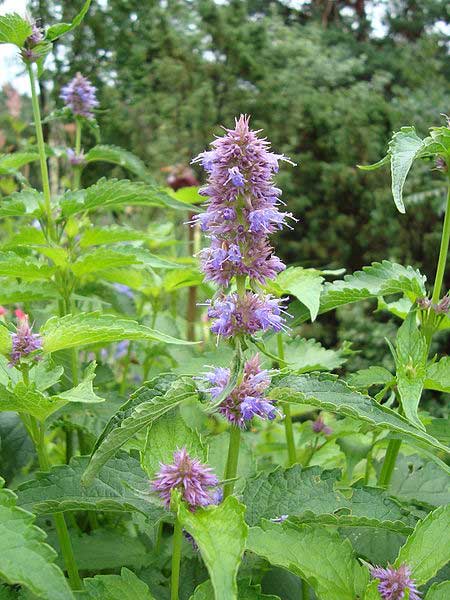
Agastache rugosa (Photo: *)
Classification System: APG IV
Superregnum: Eukaryota
Regnum: Plantae
Cladus: Angiosperms
Cladus: Eudicots
Cladus: Core eudicots
Cladus: Asterids
Cladus: Lamiids
Ordo: Lamiales
Familia: Lamiaceae
Subfamilia: Nepetoideae
Tribus: Mentheae
Subtribus: Nepetinae
Genus: Agastache
Species: Agastache rugosa
Name
Agastache rugosa (Fisch. & C.A.Mey.) Kuntze (1891)
Synonyms
Basionym
Lophanthus rugosus Fisch. & C.A.Mey., Index Seminum (LE) 1: 31. 1835.
Heterotypic
Agastache formosana (Hayata) Hayata ex Makino & Nemoto, Fl. Japan, ed. 2, 1006. 1931.
Agastache rugosa f. alba Y.N.Lee, Bull. Korea Pl. Res. 5: 24. 2005.
Elsholtzia monostachys H.Lév. & Vaniot, Repert. Spec. Nov. Regni Veg. 8: 424. 1910.
Lophanthus argyi H.Lév., Repert. Spec. Nov. Regni Veg. 12: 181. 1913.
Lophanthus formosanus Hayata, Icon. Pl. Formosan. 8: 87. 1919.
Distribution
Native distribution areas:
'Continental: Asia-Temperate
Regional: Eastern Asia
Amur, Japan, Khabarovsk, Korea, Kuril Is., Manchuria, Primorye, Taiwan
Regional: China
China North-Central
Introduced into:
Austria, Central European Rus, China South-Central, China Southeast, Germany, Laos, Sweden, Tibet, Vietnam
References: Brummitt, R.K. 2001. TDWG – World Geographical Scheme for Recording Plant Distributions, 2nd Edition
References
Primary references
Kuntze, O. 1891. Revisio generum plantarum vascularium omnium atque cellularium multarum secundum leges nomenclaturae internationales cum enumeratione plantarum exoticarum in itinere mundi collectarum. Pars II. Pp. 377–1011. Arthur Felix, Leipzig [etc.]. BHL Reference page. : 2: 511.
Additional references
Govaerts, R.H.A. 2003. World Checklist of Selected Plant Families Database in ACCESS: 1-216203. The Board of Trustees of the Royal Botanic Gardens, Kew. [unavailable for the public] Reference page.
Links
Govaerts, R. et al. 2022. Agastache rugosa in World Checklist of Selected Plant Families. The Board of Trustees of the Royal Botanic Gardens, Kew. Published online. Accessed: 2022 May 02. Reference page.
Hassler, M. 2022. Agastache rugosa. World Plants: Synonymic Checklists of the Vascular Plants of the World In: Roskovh, Y., Abucay, L., Orrell, T., Nicolson, D., Bailly, N., Kirk, P., Bourgoin, T., DeWalt, R.E., Decock, W., De Wever, A., Nieukerken, E. van, Zarucchi, J. & Penev, L., eds. 2022. Species 2000 & ITIS Catalogue of Life. Published online. Accessed: 2022 May 02. Reference page.
International Plant Names Index. 2022. Agastache rugosa. Published online. Accessed: May 02 2022.
USDA, ARS, Germplasm Resources Information Network. Agastache rugosa in the Germplasm Resources Information Network (GRIN), U.S. Department of Agriculture Agricultural Research Service. Accessed: 2022 May 02.
Vernacular names
Nederlands: Anijsplant
Agastache rugosa also known as wrinkled giant hyssop, purple giant hyssop, Indian mint, blue licorice, huo xiang (藿香), and Chinese patchouli, is an aromatic herb in the mint family, native to East Asia (China, Japan, Korea, Russian Primorye, Taiwan, India, and Vietnam).[1]
Description
Agastache rugosa leaf
Agastache rugosa is a perennial plant growing up to 40–100 cm (16–39 in) tall, with square stalks that branch at the upper part.[3] The oval-cordate leaves are oppositely arranged, 5–10 cm (2–4 in) long and 3–7 cm (1+1⁄4–2+3⁄4 in) broad, with coarsely serrated margins.[3] Some leaves have hair and/or touches of white on the underside.[3] The leaves are slightly larger than anise hyssop.[4]
From July to September in the Northern Hemisphere, purple bilabiate flowers bloom in verticillasters that are 5–15 cm (2–6 in) long and 2 cm (3⁄4 in) broad.[3] The calyx is 5–6 mm (0.20–0.24 in) long, with five narrow triangular lobes.[3] The petals are 8–10 mm (0.31–0.39 in) long, lower ones longer and the ones inside serrated. They range in color from rose to violet. The stamens are didynamous, long, and exposed.[3] The fruit is schizocarp, with obovate elliptical mericaps of 1.8 mm (0.071 in).
Cultivation
Agastache rugosa grows well in fertile, moisture-retentive soils and good sunlight. The aroma becomes weaker in shady conditions.[3]
Agastache rugosa can be propagated by both sexual and asexual means. The seeds gathered in autumn can be sown in the spring. One can also dig out the plant in autumn or early spring, divide the roots, and plant them at intervals of 30 centimetres (12 in).
Cultivars
There is one known cultivar, 'Golden Jubilee', which has yellow-green foliage.[5]
Uses
Medicinal
China
It is called huò xiāng (Chinese: 藿香)[6] in Chinese and it is one of the 50 fundamental herbs used in traditional Chinese medicine. It is used interchangeably with guang huo xiang.[7] It was traditionally used to relieve nausea, vomiting and poor appetite. It contains methyl chavicol, anethole, anisaldehyde, limonene, pinene and linalool.[8]
Chemical constituents
Chemical compounds found in the plant include:[9]
Estragole, plant
p-Anisaldehyde, plant
4-methoxycinnamaldehyde,[10] shoot
Pachypodol, leaf
Methylchavicol (60.01–88.43%),
d-Limonene
Caryophyllene
Hexadecanoic acid
Linoleic acid
Octahydro-7-methyl-methylene-4-(1-methylethyl)-1H-cyclopenta[1,3]cyclopropa[1,2]benzene[11]
References
"Agastache rugosa". Germplasm Resources Information Network (GRIN). Agricultural Research Service (ARS), United States Department of Agriculture (USDA). Retrieved 2008-02-19.
"Agastache rugosa (Fisch. & C.A.Mey.) Kuntze". World Checklist of Selected Plant Families (WCSP). Royal Botanic Gardens, Kew. Retrieved 19 April 2015 – via The Plant List.
"배초향" [Korean mint]. Korea Biodiversity Information System (in Korean). Korea National Arboretum. Retrieved 25 December 2016.
Tucker, Arthur; Debaggio, Thomas. The Encyclopedia of Herbs. London: Timber Press.
"Agastache rugosa 'Golden Jubilee'". rhs.org.uk. Retrieved 8 May 2017.
Li, Xi-wen; Hedge, Ian C. "Agastache rugosa". Flora of China. Vol. 17. Retrieved 2008-02-19 – via eFloras.org, Missouri Botanical Garden, St. Louis, MO & Harvard University Herbaria, Cambridge, MA.
"Agastache rugosa". Plants for a Future. Archived from the original on 3 March 2008. Retrieved 2008-02-14.
Home Herbal: Cook, Brew & Blend Your Own Herbs. DK Pub. 2011. ISBN 978-0-7566-7183-9.
"Species Information". Dr. Duke's Phytochemical and Ethnobotanical Databases. Retrieved 2008-02-19.
4-Methoxycinnamaldehyde inhibited human respiratory syncytial virus in a human larynx carcinoma cell line Wang K.C., Chang J.S., Chiang L.C., Lin C.C. Phytomedicine 2009 16:9 (882-886)
Chemical composition of essential oil in stems, leaves and flowers of Agastache rugosa Yang D., Wang F., Su J., Zeng L. Zhong yao cai = Zhongyaocai = Journal of Chinese medicinal materials 2000 23:3 (149-15
Retrieved from "http://en.wikipedia.org/"
All text is available under the terms of the GNU Free Documentation License

